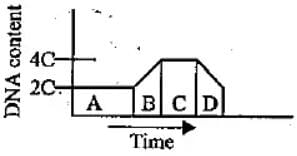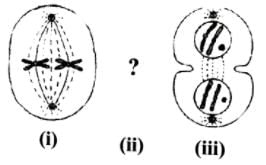Test: Mitosis (NCERT) - NEET MCQ
20 Questions MCQ Test Biology Class 11 - Test: Mitosis (NCERT)
Select the correct option:Centrioles undergo duplication during _______(i) of ________(ii), and begin to move towards opposite poles of the cell during ________(iii) stage of _________(iv).
______ is the best stage to count the number and study the morphology of chromosomes.
At which stage of mitosis, the two daughter chromatids separate from each other, migrate towards the opposite poles and are now referred to as chromosomes of the future daughter nuclei?
During anaphasic movements of chromosomes, ______ of each chromosome is/are towards the pole and _____ of the chromosome trail(s) behind.
During cell division, the spindle fibres get attached to condensing chromosome at a highly differentiated region. This region is called as
If the tissue has at a given time 1024 cells, how many cycles of mitosis had the original parental single-cell undergone?
Which phase of mitosis is essentially the reverse of prophase in terms of nuclear changes?
The given graph shows the change in DNA content during various phases (A to D) in a typical mitotic cell cycle. Identify the phases and select the correct option.

A cell's division time is 1 minute. In 20 minutes, a culture tube (culture medium) is 1/8th filled with cells. When the tube will be fully filled?

In above sequence of figures showing different stages of cell division, the missing stage (ii) is
The separation of two chromatids of each chromosome at early anaphase is initiated by
Cell would normally proceed to mitosis without interruption
Doubling of the number of chromosomes can be achieved by disrupting mitotic cell division soon after :
All the following key events take place during telophase of mitosis except:
The role of mitosis is not merely to divide a cell into two daughter cells but to ensure genetic continuity from one cell generation to another cell generation. The mechanism ensuring genetic continuity is
During which stage of mitosis do the following events occur?I. Centromeres split and chromatids separateII. Chromatids move to opposite poles
|
180 videos|362 docs|148 tests
|


















